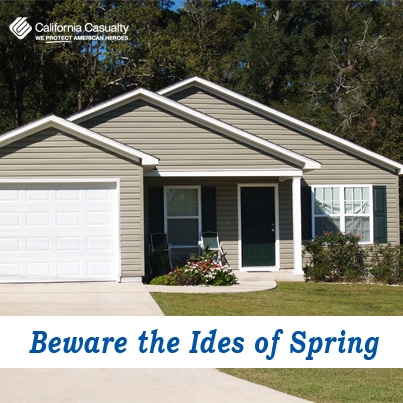Springtime; for many of us it means we can start hanging up the cold weather gear and begin getting out the gardening equipment. However, the pleasant change in weather can often lull us into a false sense of security. In fact, I’m reminded of the warning Julius Caesar was given, “Beware the Ides of March.”
So what does that warning have to do with you and me? While March marks the end of winter, it starts a dynamic time of year with a clash of late season cold fronts and warm gulf air leading to dangerous thunderstorms, flooding and even tornadoes.
Many scientists warn that between climate change and El Nino, we are facing some of the most extreme and unpredictable weather patterns ever seen: one of the worst droughts and fire seasons ever in California followed by torrential rains and heavy snows, record flooding in Texas, Missouri and South Carolina, rare deadly December tornadoes across the Midwest and South and unprecedented holiday warmth in the Northeast.
Maybe we should change Shakespeare’s line to “Beware the Ides of Spring.”
Springtime Dangers
Flooding
Flood season begins in spring as winter snow and ice melt. Severe thunderstorms can add tremendous amounts of water to the runoff, often inundating cities and towns located in flood zones.
Flooding is the most common and costly natural disaster in the United States, causing an average of $50 billion in economic losses each year. Anyone living in a low-lying area near a lake, river or stream should make sure they are protected. Homeowners and renters insurance don’t cover floods from rivers, streams, or other runoff; if you want your home and valuables protected, you need flood insurance that often has a 30 day waiting period.
Flooding caused by a damaged roof or broken water pipe is covered by most homeowners insurance. While it can happen any time of year, springtime thawing can be the culprit. Do you have enough coverage if water should destroy your valuable possessions? The Federal Emergency Management Agency estimates that just two inches of water can cause more than $10,000 for repairs and replacement of flooded items. Six inches of water can add up to more than $30,000.
Fires
While a house fire can happen any time of year, spring marks the start of wildfire season. More than 4,600 structures were destroyed by wildfires in 2015, 2,667 of those were homes or apartments.
Fuels, such as grasses and brush, start to dry out as temperatures warm. Before they become a threat to your home you should mow and trim back any grasses, trees or bushes to create a 30 foot defensible space. Don’t forget to move gas grills, firewood and other combustibles 15 to 30 feet away from your home. You can find more wildfire prevention tips here.
Tornadoes
The volatile mix of warm and cold usually results in tornadic activity. Almost every state has experienced a tornado, and if you live in the South, Midwest or points east you may have already taken these tornado preparedness actions:
- Identify a safe place in your house (basement, storm shelter or sturdy interior reinforced room on the lowest floor of the home
- Prepare an emergency kit with first aid supplies, food, water and sanitary needs (include important medicines, eye glasses, etc.)
- Practice tornado drills
Severe Thunderstorms
Thunderstorms are the top cause of insured loss each year in the United States due to high winds, large hail and dangerous lightning. When a thunderstorm approaches, immediately move indoors and away from windows and avoid electrical equipment and corded telephones. Preparations for severe thunderstorms are much the same as tornadoes.
How to Protect Your Property
Before wild weather has a chance to threaten your home, here are some key tips to help prevent damage:
- Check roofs and shingles for damage, lifting or other signs that they might leak
- Clean gutters and drain spouts and make sure they direct water away from your home’s foundation
- Look for loose boards, cracking or other damage on decks and porches to avoid tripping, falls or other hazards
- Inspect the exterior of your home for cracks, holes or exposed wood or siding that could allow water, insects or small wildlife to get in
- Make sure chimneys and vents are well sealed and sturdy to prevent water or wind damage
- Trim back trees and bushes, looking for weak or broken branches or other damage, to protect against them falling into roofs or siding
Check Your Insurance
Before a catastrophe strikes, the Insurance Information Institute says you should:
- Purchase homeowners or renters insurance
- Get flood insurance if you live in a flood prone area
- Review your policy so you understand your coverages (replacement costs, replacement of personal possessions, and additional living expenses)
- Make a full inventory of everything you own
After a Disaster
If the unexpected should occur, you should take these steps:
- Secure your property from further damage or theft
- Contact your insurance company as soon as possible
- Catalogue your losses and take pictures
- Save receipts of meals, purchases and hotels while you are unable to live at home
- Be careful of fraudulent contractors
Now is good time to reevaluate your protection against the unpredictable moods of spring; contact a California Casualty advisor to purchase flood insurance, get a review of your policy or add any coverage that you might need. Give a call today at 1.800.800.9410 or visit www.calcas.com.
Resources for this article:
https://www.floodsmart.gov/floodsmart/pages/flooding_flood_risks/the_cost_of_flooding.jsp
https://www.nifc.gov/fireInfo/fireInfo_statistics.html
https://www.redcross.org/prepare/disaster/tornado
https://www.iii.org/article/making-sure-your-home-properly-covered-disaster
https://www.redcross.org/find-help/disaster-recovery/recovering-financially
- California Casualty Earns Financial Stability Rating® of A, Exceptional, From Demotech, Inc. - April 28, 2025
- Music & Arts Grant Recipients – 2024 - December 13, 2024
- Understanding Auto and Home Insurance Rate Changes - December 3, 2024

